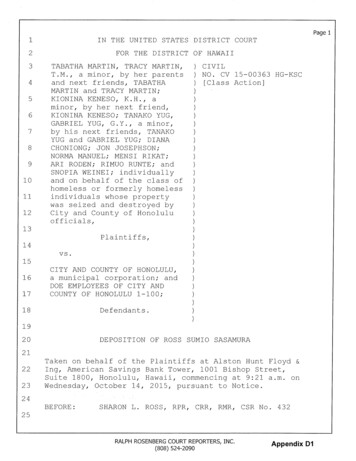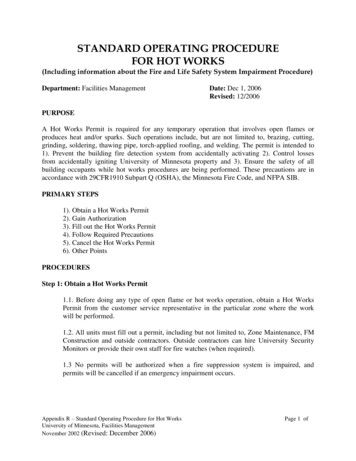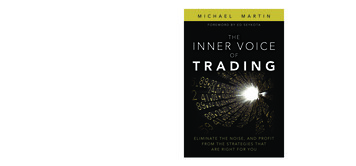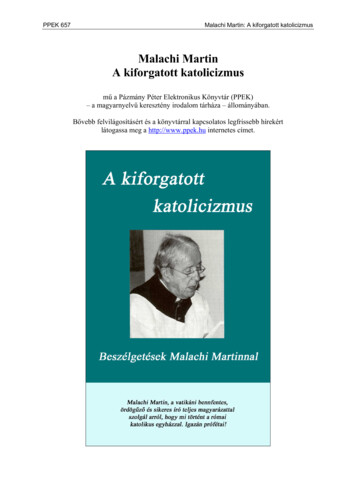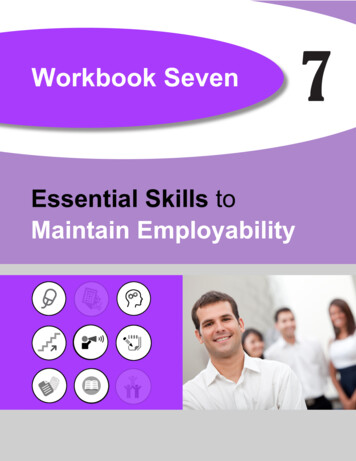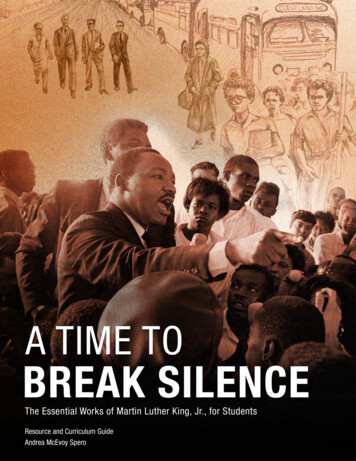
Transcription
The Essential Works of Martin Luther King, Jr., for StudentsResource and Curriculum GuideAndrea McEvoy Spero
Designed by Design Action CollectiveArtwork by Evan Bissell
A TIME TOBREAK SILENCEThe Essential Works of Martin Luther King, Jr., for StudentsResource and Curriculum GuideDeveloped by Andrea McEvoy Spero, Education Director ofThe Martin Luther King, Jr. Research and Education Institute
TABLE OF CONTENTSIntroduction.2Lesson One: Love and Faith.4Lesson Two: Nonviolent Resistance.8Lesson Three: Consequences of War. 14Lesson Four: Young People Working for Justice. 20Lesson Five: The Power of Freedom. 24Lesson Six: Suffering, Hope, and the Future. 36Martin Luther King, Jr. and the African American Freedom Struggle Timeline. 40National Social Studies Standards and Common Core State Standards . 47
Introduction andAcknowledgementsABOUT THE GUIDEThe following Common Core aligned teachers’ companion curriculumguide and online resources were developed by the Martin Luther King,Jr. Research and Education Institute at Stanford University and serves asa companion to A Time to Break Silence: The Essential Works of MartinLuther King, Jr., for Students, published by Beacon Press. Arrangedthematically in six parts, the book collection includes eighteen selectionsand is introduced by award-winning author Walter Dean Myers. Includedare some of Dr. King’s most well-known and frequently taught classicworks, like “Letter from Birmingham Jail” and “I Have a Dream,” as wellas lesser-known pieces such as “The Sword that Heals” and “What Is YourLife’s Blueprint?,” which speak to issues young people face today.The online resource, Freedom’s Ring: King’s “I Have a Dream” Speech(www.freedoms-ring.org), and curriculum guide offer innovative strategiesfor engaging students in the study of Dr. King and the African AmericanFreedom Struggle. In challenging students to rethink the traditional understandings of King, these activities require students to connect the past andpresent. Through these lessons and resources we hope students may beginto see themselves as actors in the ongoing struggle for freedom, equality,reconciliation, and justice.ACKNOWLEDGMENTSThe Martin Luther King, Jr. Research and Education Institute and BeaconPress would like to extend deep gratitude to the creators and contributorsof the Freedom’s Ring: King’s “I Have a Dream” Speech website andaccompanying curriculum guide. Evan Bissell’s artwork, vision, and2
knowledge of the movement for peace and justice and Erik Loyer’s gift fordesigning innovative online tools gave renewed life to King’s most famousspeech. Sabiha Basrai of Design Action Collective is the talented designerbehind the curriculum guide. Matt Herron and Danny Lyon generouslyallowed for the use of their photos as the basis for particular sketches.Erin Cook permitted us to adapt her Beyond Vietnam lesson. Beacon Pressgratefully acknowledges the Unitarian Universalist Veatch Program atShelter Rock for its generous support of the King Legacy series. Finally,we’d like to extend gratitude to the many individuals whose tirelessactivism contributed to the freedom struggle. It is in their honor that weendeavor to learn from the past and build a more just future.ORDERING INFORMATIONA Time to Break Silence: The Essential Works of MartinLuther King, Jr., for StudentsMartin Luther King, Jr.Edited and Introduced by Walter Dean MyersPaperback: 978-0-8070-3305-0 / 14.00 / 272 pagesExam copy price: 3.00Also available in e-book and hardcoverExamination copies of A Time to Break Silence are available to teachersseeking titles to review for inclusion in their school’s curriculum or in theirclasses as multiple-copy classroom adoptions. Desk copies are available foran adopted text. To request an exam or desk copy, visit our distributor’swebsite, www.randomhouse.com/highschool.If you are interested in placing a bulk student copy, you may place yourorder through your preferred bookseller or through an educationaldistributor.To support the use of A Time to Break Silence in the classroom, thiscurriculum and supplemental resources are available online throughwww.thekinglegacy.org/teachers3
LESSON ONE:Love And Faithbased on a photo by Danny Lyon4
ESSENTIAL QUESTION:King often spoke of the inherent role of love and faith within the movement for justice. Why did King believe love was at the center of thestruggle for justice?ACTIVITY ONE:Poetry and Photography Gallery Walk1. Introduce students to the Freedom’s Ring: King’s “I Have a Dream”Speech website. Using the index, ask students to choose the theme“Love & Faith”. Within this theme, ask students to explore “A BaptistPreacher” and “Army of Love”. Lead a discussion about the role of loveand faith in the African American freedom struggle.2. Next, ask students to read the “Love and Faith” chapter in the Kinganthology. Ask students to choose three to six sentences that resonatewith their life experiences.3. Instruct students to break their chosen quote into phrases and thenwrite each phrase on a strip of paper. Their writing should be largeenough and clear enough so that it can be viewed from a few feet away.Put all phrases together on a large table.4. Ask each student to choose a photo from the online gallery or bookslisted in the resource section at the end of this lesson. Each studentwill then print or photo copy their photo and write a brief placard. Theplacard should include the photographer’s name, title of photo, year,and a few sentences to describe the context.5. Return to the strips of paper with quotes and ask students to choosefour to five phrases to connect with their photo. Students will placetheir photo, phrases and placards together on a classroom wall. Thephrases should be arranged in a way that creates a short poem directlyunderneath the photo and placard.6. Invite students to do a gallery walk and listen to Soundtrack for aRevolution.5
ACTIVITY TWO:“Love”1. How do you define love? How do others define love? Ask studentsto seek out and bring to class poetry, literature, or quotes by famousindividuals about the definition of love. Lead a discussion and create aclass definition of love. Add your class definitions of love to the gallerywalk.2. Read the information and watch the interviews on the Freedom’s Ring:King’s “I Have a Dream” Speech website on the themes of “Love andFaith” and “Tactics of the Movement”.3. Listen to “Loving Your Enemies” on the Martin Luther King, Jr.Research and Education Institute website.4. How does King define love in “Loving Your Enemies”? How has hisChristian faith contributed to his understanding?5. Lead a class discussion. Is it possible for you to forgive a person whohates you or has caused you harm? Is it possible for you to love aperson or group of people who have caused harm to others? What doesit take to end a cycle of hate?ACTIVITY THREE:American Poets1. Lead the class in a study of African American poets, such as LangstonHughes, Maya Angelou, and Zora Neale Hurston. Identify and discussliterary elements used by these poets.2. Return to King’s words from the selections in the chapter and theFreedom’s Ring: King’s “I Have a Dream” Speech website theme of“Love and Faith.” Think about the literary devises utilized by King. Askstudents to find examples of metaphor, simile, descriptive language andbiblical references.3. Ask students to add poetry to the gallery wall from poets studied inclass.6
EXTENSION ACTIVITY:Using June Jordan’s Poetry for the People, guide students in poetry writingaround the themes of love, reconciliation, transformation, and justice asthey relate to contemporary issues.Resources:Soundtrack for a Revolution, a film by Bill Guttentag and Dan SturmanThis Light of Ours: Activist Photographers of the Civil Rights Movement, edited by Leslie G. KelenFreedom’s Ring: King’s “I Have a Dream” Speech, www.freedoms-ring.orgPoetry for the People: A Revolutionary Blueprint, by June JordanCivil Rights Movement Veterans websiteThe Martin Luther King, Jr. Research and Education Institute website7
LESSON TWO:NonviolentResistance8
ESSENTIAL QUESTION:Is it possible for nonviolent direct action to transform a community?ACTIVITY ONE: PRIMARY SOURCE ANALYSIS1. Split the class in half. Each half will receive either a copy of “The SixPrinciples of Nonviolence” or “Six Steps of Nonviolent Direct Action”(provided after this lesson description). In pairs, ask students to readand analyze the handout. Encourage them to write their thoughts andquestions in the margins. After they have finished, have each pair seekout another pair with the other document. Ask them to teach eachother about their assigned document.SIX PRINCIPLES OF NONVIOLENCE1. Nonviolence is a way of life for courageous people. It is active nonviolentresistance to evil.2. Nonviolence seeks to win friendship and understanding. The end result ofnonviolence is redemption and reconciliation.3. Nonviolence seeks to defeat injustice, not people. Nonviolence recognizesthat evil doers are also victims.4. Nonviolence holds that suffering can educate and transform. Nonviolencewillingly accepts the consequences to its acts.5. Nonviolence chooses love instead of hate. Nonviolence resists violenceto the spirit as well as the body. Nonviolence love is active, not passive.Nonviolent love does not sink to the level of the hater. Love restorescommunity and resists injustice. Nonviolence recognizes the fact thatall life is interrelated.6. Nonviolence believes that the universe is on the side of justice. Thenonviolent resister has deep faith that justice will eventually win.Source: The Martin Luther King, Jr. Center for Nonviolent Social Change9
SIX STEPS FOR NONVIOLENT DIRECT ACTIONSTEP ONE: INFORMATION GATHERINGIdentify the issues in your community and/or school that are in need of positive change. Tounderstand the issue, problem or injustice facing a person, community, or institution, youmust increase your understanding of the problem. Your investigation should include all sidesof the issue and may include formal research and listening to the experiences of others.STEP TWO: EDUCATE OTHERSIt is essential to inform others, including your opposition, about your issue. In order to causechange, the people in the community must be aware of the issue. By educating others you willminimize misunderstanding and gain support and allies.STEP THREE: PERSONAL COMMITMENTCheck and affirm your faith in the philosophy and methods of nonviolence. Causing changerequires dedication and long hours of work. Meet with others regularly to stay focused onyour goal. Prepare yourself to accept sacrifices, if necessary in your work for justice.STEP FOUR: NEGOTIATIONSUsing grace, humor and intelligence, confront the other individuals which need to participatein this positive change. Discuss a plan for addressing and resolving these injustices. Look forwhat is positive in every action and statement the opposition makes. Do not seek to humiliatethe opponent but call forth the good in the opponent. Look for ways in which the opponentcan become an ally.STEP FIVE: DIRECT ACTIONThese are actions taken to convince others to work with you in resolving the injustices. Directaction imposes a “creative tension” into the conflict. Direct action is most effective when itillustrates the injustice it seeks to correct.There are hundreds of direct action, including:Boycotts --- refusal to buy productsSit-insMarches and ralliesLetter-writing and petition campaignsPolitical action and votingSTEP SIX: RECONCILIATIONNonviolence seeks friendship and understanding with the opponent. Nonviolence does notseek to defeat the opponent. Nonviolence is directed against evil systems, forces oppressivepolicies, evil and unjust acts, not against persons.Derived from the essay “Letter from a Birmingham Jail”,Martin Luther King Jr.10
ACTIVITY TWO: “THE SWORD THAT HEALS”1. Read the selection, “The Sword That Heals” and identify quotes thatconnect with the “Six Steps for Nonviolent Direct Action.”2. Ask students to research other direct action campaigns: MontgomeryBus Boycott, Birmingham Campaign, Mississippi Freedom Summer,Greensboro Lunch Counter Sit-ins, Freedom Rides. Many of theseevents are found in the “Tactics of the Movement” theme on theFreedom’s Ring: King’s “I Have a Dream” Speech website. Encourage yourstudents to think beyond the civil rights movement and choose currentissues important to them.3. Identify the steps of each of these events based on the “Six Steps ofNonviolent Direct Action.”ACTIVITY THREE: PHILOSOPHY OR STRATEGY?1. Read about and listen to reflections of direct action campaigns from theFreedom’s Ring: King’s “I Have a Dream” Speech website. Start with thephrases “soul force” and “to dramatize.”2. Discuss the following question: Did activists see nonviolent directaction as a successful strategy or a way of life?Resources:Freedom’s Ring: King’s “I Have a Dream” Speech, www.freedoms-ring.orgHandout: Six Principles of Nonviolence11
LESSON THREE:Consequencesof War12
ESSENTIAL QUESTION:Why did King make the choice to speak out against USinvolvement in Vietnam when he risked doing harm to his status as acivil rights leader, as well as harming the movement itself?ACTIVITY ONE: WHERE DO YOU STAND?1. Read the following introduction to students:On April 4, 1967, King made his most public and comprehensivestatement against the Vietnam War. Addressing a crowd of 3,000people in New York City’s Riverside Church, King delivered a speechentitled “Beyond Vietnam.” King pointed out that the war effort was“taking the young black men who have been crippled by our societyand sending them 13,000 miles away to guarantee liberties in SoutheastAsia which they had not found in southwest Georgia and East Harlem.”Although some activists and newspapers supported King’s statement,most responded with criticism. King’s civil rights colleagues beganto disassociate themselves from his radical stance, and the NAACPissued a statement against merging the civil rights movement and peacemovement.2. Ask students to “take a stand” on King’s decision to denounce thewar in Vietnam. Create an imaginary line with one end representingagreement and the other end representing disagreement. Based onwhere they stand, split the class in half. The half that is closet to the“disagree” position will receive the primary sources that support King’sdecision, and vice versa.3. Give each group the packet containing the letter to the editor andeditorials. Groups should use the documents to develop as strong anargument as possible.13
“DR. KING’S ERROR,” NEW YORK TIMES,APRIL 7, 1967, 36.In recent speeches and statements the Rev. Dr. Martin Luther King Jr. haslinked his personal opposition to the war in Vietnam with the cause ofNegro equality in the United States. The war, he argues, should be stoppednot only because it is a futile war waged for the wrong ends but also becauseit is a barrier to social progress in this country and therefore preventsNegroes from achieving their just place in American life.This is a fusing of two public problems that are distinct and separate. Bydrawing them together, Dr. King has done a disservice to both. The moralissues in Vietnam are less clear-cut than he suggests; the political strategy ofuniting the peace movement and the civil rights movement could very wellbe disastrous for both causes.Because American Negroes are a minority and have to overcome uniquehandicaps of racial antipathy and prolonged deprivation, they have ahard time in gaining their objectives even when their grievances are selfevident and their claims are indisputably just. As Dr. King knows from theMontgomery bus boycott and other civil rights struggles of the past dozenyears, it takes almost infinite patience, persistence and courage to achievethe relatively simple aims that ought to be theirs by right.The movement toward racial equality is now in the more advanced andmore difficult stage of fulfilling basic rights by finding more jobs, changingpatterns of housing and upgrading education. The battle grounds in thisstruggle are Chicago and Harlem and Watts. The Negroes on these frontsneed all the leadership, dedication and moral inspiration that they cansummon; and under these circumstances to divert the energies of the civilrights movement to the Vietnam issue is both wasteful and self-defeating.Dr. King makes too facile a connection between the speeding up of thewar in Vietnam and the slowing down of the war against poverty. Theeradication of poverty is at best the task of a generation. This “war”inevitably meets diverse resistance such as the hostility of local politicalmachines, the skepticism of conservatives in Congress and the intractabilityof slum mores and habits. The nation could afford to make more funds14
available to combat poverty even while the war in Vietnam continues, butthere is no certainly that the coming of peace would automatically lead to asharp increase in funds.Furthermore, Dr. King can only antagonize opinion in this country insteadof winning recruits to the peace movement by recklessly comparingAmerican military methods to those of the Nazis testing “new medicine andnew tortures in the concentration camps of Europe.” The facts are harsh, butthey do not justify such slander. Furthermore, it is possible to disagree withmany aspects of United States policy in Vietnam without whitewashingHanoi.As an individual, Dr. King has the right and even the moral obligationto explore the ethical implications of the war in Vietnam, but as oneof the most respected leaders of the civil rights movement he has anequally weighty obligation to direct that movement’s efforts in the mostconstructive and relevant way.There are no simple or easy answers to the war in Vietnam or to racialinjustice in this country. Linking these hard, complex problems will leadnot to solutions but to deeper confusion.“LETTERS TO THE EDITOR OF THE TIMES,” NEW YORKTIMES, APRIL 12, 1967, 46. DR. KING BACKEDTo the Editor:The New York Times has rendered a great disservice to thepeace and civil right movements in this country by making afutile attempt to dissociate the two.In an April 7 editorial The Times severely criticized theRev. Dr. Martin Luther King Jr., president of the SouthernChristian Leadership Conference, for “fusing” the peace andcivil rights issues into a single concern.Logically, the welfare of non-white peoples in this nationis inextricably linked with the welfare of nonwhite peoples15
around the world. American negroes, Puerto Ricans, Indiansand Mexicans allhave exceedingly direct stake in theAdministration’s posture in Vietnam. They have experiencedfirst hand the Governement’s disrespect for humanity anddignityat home and are compelled to voice their outrage atthe calculated destruction abroad their Vietnamese brothers.The American Government seems, in fact, to be embarked upon aprogram of systematic genocide in Vietnam and it is for thisreason, perhaps more than any other, that colored peopleseverywhere must speak out and act courageously.Those Americans opposing the war cannot any longer be guiltyof silence while American nonwhites who have been deprived oftheir full citizenship are sent to their death in PresidentJohnson’s illegal, immoral and unjust war.In order to dramatize the growing opposition to the war,thousands of Americans of all races, creeds, religions andnational origins will gather together in San Francisco andNew York City on April 15 for Spring Mobilization protestmarch and rally.Before the eyes of the world the Spring Mobilization willlaunch a sustained, serious movement which will begin to putan end to the senseless slaughter that is taking place in thename of democracy.[Rev.] JAMES BEVELLNational DirectorSpring Mobilization CommitteeTo End the War in VietnamNew York, April 8, 196716
WAR STAND REJECTEDTo the EditorI consider that my support of the Urban League and membershipin the N.A.A.C.P, to say nothing of my contributions tovarious liberal causes, entitle me to consider myself a whiteperson of goodwill as that term was used by Dr. Martin LutherKing in The Times of April 5.Far from being willing personally to boycott the Vietnamwar, however, or even to have my son claim status as aconscientious objector, I assert that it is necessary tosupport the war in Vietnam.Dr. King’s simplistic assertion that our Government is the“greatest purveyor of violence in the world today” and hisanalogy between the use of new weapons by our forces inVietnam and the use of strange medicines and torture byHitler’s murderers in the concentration of Nazi Germany raisegrave doubts in my mind as to his ability to think clearly.Dr. King and his ilk do not speak for me and mine.JOSEPH LEWIS SIMONNew York, April 5, 196717
ACTIVITY TWO: “BEYOND VIETNAM”1. Introduce King’s “Beyond Vietnam” speech by showing Eyes on thePrize II: The Promised Land (first 10 minutes). Ask students to readboth “Beyond Vietnam” and “The Casualties of the War in Vietnam”and be ready to discuss.Some questions to consider for the discussion:a. Was King’s decision to speak out against the war a departure fromhis stated philosophical, political, and/or social commitments?b. What relevance does his role as a clergyman have for King’sposition? What about as a Nobel Peace Prize recipient? What abouthis role as a civil rights leader?c. Do you believe there was a relationship between the war inVietnam and the civil rights struggle at home? Why or why not?d. Were there any inconsistencies with King’s stated position onthe war in Vietnam and his stated position as a civil rights leader?(Consider the role of nonviolence.)e. What were some of the main criticisms King’s opponents maderegarding his statement on the war in Vietnam? What were some ofthe main arguments made by those defending King’s position?f. What if King had not taken a position on the war in Vietnam?Would it have undermined his stated commitment to nonviolenceand social justice, or would it have merely highlighted hiscommitment to the civil rights movement?g. What role, if any, might King’s race have had to do with how hisstatement was received?h. Do you believe that moral, religious, and political considerationsshould be separated if it serves a tactical goal?18
i. In his letter “Dr. King Backed,” James Bevel states, “Logically, thewelfare of non-white peoples in this nation is inextricably linkedwith the welfare of non-white peoples around the world.” Do youagree? Why or why not?j.What sort of impact do you believe King’s decision to speak outagainst the war had on the civil rights movement? If you believe itharmed the movement, was it worth it?k. Ralph Bunche stated that, “Dr. King should positively andpublicly give up one role or the other. The two efforts have two littlein common.” Do you agree?l.Finally, how are these issues relevant today? How might this relateto our current situation around the world? Could the case be madethat our current foreign policy has implications for domesticpolicy? How?ACTIVITY THREE: TAKING A STAND1. Ask students to return to the imaginary line and choose where to stand.Did their position change? Of the resources, discussions and readings,what influenced their position most?2. As a class, choose a contemporary modern military conflict andconduct research. After gathering information and various positionsabout the conflict, discuss the following questions: Do King’s positionson Vietnam hold true for this conflict as well? What aspects are similar?What aspects are different? What is your position on this conflict?Resources:Eyes on the Prize: America’s Civil Rights Years, documentary by HenryHampton at Blackside, Inc.19
LESSON FOUR:Young PeopleWorking forJusticeBased on a photo by Matt Herron,www.takestockphotos.com20
ESSENTIAL QUESTIONWhat role did young people play in the freedom struggle?ACTIVITY ONE: PARENT-CHILD NEGOTIATIONS1. Watch either Eyes on the Prize segment on Birmingham or Children’sMarch from Teaching Tolerance.2. Tell students that they are going to be learning about the role that youngpeople played in the African American freedom struggle, specificallyin the Birmingham campaign, and write Malcolm X’s statement, “Realmen don’t put their children on the firing line,” on the board.3. Begin with discussion prompts or quick write prompts: Would you bewilling go to jail to challenge an unjust law? Would you let your childgo to jail in an effort to overturn an unjust law? Would your parentsallow you to go to jail in an effort to secure justice for your community?4. Split the class in half and ask students to line up facing each other. Onegroup of students will play the role of parents and one group the roleof sons/daughters. Explain that they live in Birmingham in the 1960s.The daughters/sons should try to convince their parents to let themparticipate in the march. The parents do not want their children to riskarrest or worse. Allow the students to role-play the discussion for threeto four minutes.ACTIVITY TWO: ROLE OF YOUTH IN THE MOVEMENT1. Read one of the following of King’s works; “The Time for FreedomHas Come,” “The Burning Truth in the South,” or “Black and WhiteTogether” from the anthology. Ask students to take notes on the role ofyouth in the movement.2.Return to the Freedom’s Ring: King’s “I Have a Dream” Speech websiteand ask students to listen to interviews and read entries on the themes21
of “Tactics of the Movement” and “A People’s Dream”. In particular,students may want to explore the entries titled “Role of Youth,” “YouthChallenge Montgomery,” “Freedom Now!,” “Direct Action,” “DramatizeInjustice” and “Fierce Urgency of Now.”3. Using Ellen Levine’s Freedom’s Children, provide students with firsthandaccounts from youth who participated in the movement.4. In a class discussion, compare King’s description of youth in themovement and the young people’s account. Why did they get involved?What did they believe? How did they describe their experiences?ACTIVITY THREE: UNSUNG HEROES AND SHEROES1. Research the following young people and events. Suggested resourcesinclude The Civil Right Movement Vets website and Ellen Levine’s bookFreedom’s Children, and the Martin Luther King, Jr. Encyclopedia fromthe Martin Luther King, Jr Research and Education Institute.Claudette ColvinBarbara JohnsChildren’s March in BirminghamLittle Rock Nine (Ernest Green, Elizabeth Eckford, Jefferson Thomas,Terrence Roberts, Carlotta Walls LaNier, Minnijean Brown, GloriaRay Karlmark, Thelma Mothershed, and Melba Pattillo Beals)Mary Loiuse SmithJoann BlandJohn LewisDiane NashJulian Bond22
Resources:Eyes on the Prize, documentary by Henry Hampton at Blackside, Inc.The Children’s March, a film and curriculum guide by Teaching ToleranceFreedom’s Children by Ellen LevineCivil Rights Movement Vets websiteThe Martin Luther King, Jr. Encyclopedia from the Martin Luther King, Jr.Research and Education websiteFreedom’s Ring: King’s “I Have a Dream” Speech website23
LESSON FIVEThe Powerof Freedom24
ESSENTIAL QUESTION:Did the nonviolent direct action, which King describes in his “Letterfrom a Birmingham Jail,” successfully, transform Birmingham,Alabama, from a segregated to a just society in 1963?ACTIVITY ONE: BIRMINGHAM1. Watch the Eyes on the Prize segment on Birmingham2. Ask student to read King’s “Letter from Birmingham Jail.” As a class,read the following excerpts and discuss the questions following eachquote.“Moreover, I am cognizant of the interrelatedness of all communitiesand states. I cannot sit idly by in Atlanta and not be concerned aboutwhat happens in Birmingham. Injustice anywhere is a threat to justiceeverywhere. We are caught in an inescapable network of mutuality,tied in a single garment of destiny. Whatever affects one directly,affects all indirectly. Never again can we afford to live with the narrow,provincial ‘outside agitator’ idea. Anyone who lives inside the UnitedStates can never be considered an outsider anywhere within its bounds.”The line in bold print is considered one of King’s most famous quotations.What does this mean for individuals who have ignored the issues ofBirmingham? What does this mean today for each of us living in theUnited States?“You may well ask: ‘Why direct action? Why sit-ins, marches and soforth? Isn’t negotiation a better path?’ You are quite right in callingfor negotiation. Indeed, this is the very purpose of direct action.Nonviolent direct action seeks to create such a crisis and foster sucha tension that a community which has constantly refused to negotiateis forced to confront the issue. It seeks so to dramatize the issue that itcan no longer be ignored. My citing the creation of tension as part ofthe work of the nonviolent resister may sound rather shocking. But Imust confess that I am not afraid of the word ‘tension.’ I have earnestlyopposed violent tension, but there is a type of constructive, nonviolent tension25
which is necessary for growth. Just as Socrates felt that it was necessaryto create a tension in the mind so that individuals could rise from thebondage of myths and half truths to the unfettered realm of creativeanalysis and objective
Luther King, Jr., for Students. Martin Luther King, Jr. Edited and Introduced by Walter Dean Myers Paperback: 978-0-8070-3305-0 / 14.00 / 272 pages Exam copy price: 3.00 Also available in e-book and hardc

